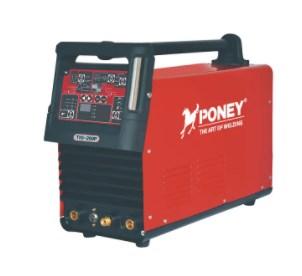Determinant of Weld Quality: Insights from MIG TIG ARC Plasma Cutters

The quality of a weld is a complex interplay of various factors, with the stability of the arc being one of the most critical. In the context of the MIG TIG ARC Plasma Cutter, the arc's stability directly influences the uniformity, strength, and aesthetic appeal of the weld. This article delves into the intricacies of how arc stability affects the welding process and the final quality of the welds produced by these advanced cutting and joining tools.
The arc in MIG TIG ARC Plasma Cutters is the electrical discharge that occurs between the electrode and the workpiece, or between the torch and the workpiece in the case of plasma cutting. This arc is responsible for generating the intense heat required to melt the base metal and the filler material if used, to create a solid joint. The stability of this arc is paramount, as any fluctuations can lead to inconsistencies in the weld pool, which in turn can result in defects such as porosity, undercutting, or incomplete fusion.
One of the primary factors affecting arc stability is the quality of the power source. A consistent and clean power supply is essential for maintaining a stable arc. Voltage fluctuations, whether due to power grid issues or the welding machine itself, can cause the arc to flicker or extinguish, leading to an inconsistent weld. High-quality welding machines are designed to regulate the power output, ensuring a stable arc even under varying conditions.
The type of electrode used in MIG TIG ARC Plasma Cutter also plays a significant role in arc stability. The electrode's material, diameter, and shape all influence the arc's behavior. For instance, a larger diameter electrode may produce a more stable arc but at the cost of reduced precision. Conversely, a smaller diameter electrode allows for more intricate work but may be more susceptible to arc instability.
In MIG welding, the wire feed speed and the shielding gas flow rate are crucial for maintaining a stable arc. If the wire feed is too slow, the arc can become erratic, leading to an uneven weld bead. On the other hand, if the wire feed is too fast, the arc may become too hot, causing the weld pool to become too large and potentially leading to burn-through. Similarly, the shielding gas must be carefully controlled to prevent contamination of the weld pool and to ensure that the arc remains stable.
For ARC plasma cutters, the stability of the plasma arc is influenced by the nozzle design, the gas type and flow rate, and the power settings. A well-designed nozzle helps to focus the plasma stream, while the correct gas flow rate ensures that the plasma arc remains concentrated and does not disperse. The power settings must be adjusted according to the material thickness and type to achieve optimal cutting performance.
Operator skill is another critical factor in maintaining arc stability. A skilled welder or MIG TIG ARC Plasma Cutter operator can make adjustments in real time to compensate for any changes in the welding environment or the material being worked on. This includes adjusting the torch angle, the travel speed, and the distance between the torch and the workpiece.
Environmental factors, such as wind, humidity, and temperature, can also impact arc stability. Wind can cause the arc to sway, while high humidity can lead to moisture in the shielding gas, which can affect the arc's stability. Welding in extreme temperatures can also pose challenges, as the material's thermal properties can change, affecting the heat input and the arc's behavior.
Regular maintenance of the MIG TIG ARC Plasma Cutters is essential to ensure that all components are in good working order. This includes cleaning the contact tips, replacing worn-out parts, and ensuring that the gas and power supply systems are functioning correctly.
In conclusion, the stability of the arc in MIG TIG ARC Plasma Cutters is a multifaceted issue that requires attention to detail from the operator, the quality of the equipment, and the welding environment. By understanding the factors that influence arc stability and taking the necessary steps to control them, welders and MIG TIG ARC Plasma Cutter operators can significantly improve the quality of their work, resulting in stronger, more aesthetically pleasing welds that meet the highest industry standards.
- Art
- Causes
- Crafts
- Dance
- Drinks
- Film
- Fitness
- Food
- Jogos
- Gardening
- Health
- Início
- Literature
- Music
- Networking
- Outro
- Party
- Religion
- Shopping
- Sports
- Theater
- Wellness


